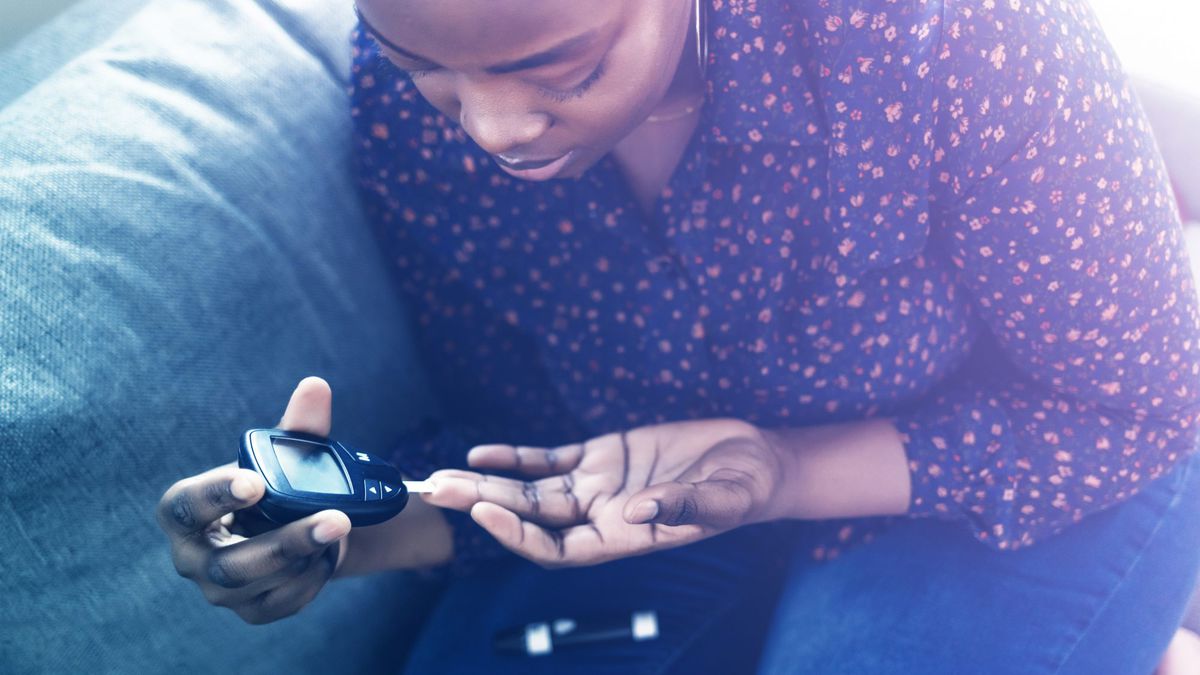At their core, both diseases involve abnormally high levels of sugar in the bloodstream, which is a dangerous, if not life-threatening situation. That occurs as the result of deficiencies in the hormone insulin. In a healthy body, insulin, which is produced by your pancreas, heads to the bloodstream after you eat to break down the sugars from food before escorting them into your cells where they wait to be used as energy.
In type 1 diabetes, the body no longer makes any insulin at all, which means that blood sugar levels rise to sometimes stratospheric levels in the blood. Type 2 is a completely different physiology, with the insulin getting less and less effective over time, rather than shutting down abruptly, Mary Vouyiouklis Kellis, MD, an endocrinologist at the Cleveland Clinic, tells Health. This is called insulin resistance.
Type 1 diabetes represents less than 5% of diabetes cases, and type 2 diabetes 90 to 95%. Other, rarer forms of the condition, make up the rest.
The causes of type 1 and type 2 are different
Type 1 diabetes is an autoimmune condition, which means that your immune system mistakenly attacks your body. In the case of type 1 diabetes, immune-system cells go after the insulin-producing beta cells in the pancreas, which causes insulin production to suddenly turn off.
No one knows exactly why your body goes on the offensive, but there are probably many contributing factors. "We don't completely understand why this happens but there is some data that a viral infection can trigger the process if you already have a predisposition," says Dr. Vouyiouklis Kellis. "You may already have antibodies [the immune-system cells that attack the pancreas] but the second hit is a viral infection." That predisposition could also be genetic.
With type 2 diabetes, genetics, including family history, can also play a role, but here the main risk comes from being obese or overweight, as well as other lifestyle factors, such as not being active and eating unhealthy foods, Jasmine D. Gonzalvo, PharmD, director of the Centre for Health Equity and Innovation at Purdue University in West Lafayette, Indiana, tells Health. "The body still has some ability to produce insulin, but the body has a resistance to the insulin." In type 2 diabetes, the cells may also have difficulty using the insulin effectively, called insulin resistance.
Type 1 and type 2 affect different groups of people
Type 1 diabetes used to be called "Juvenile Onset Diabetes" because, although it can affect anyone, it most often strikes kids aged four to six and those aged 10 to 14.
Type 2 diabetes, originally called adult-onset diabetes, mostly affects adults, but the age at diagnosis is getting younger.
"There's been more of a grey area within the last decade or so, where you see an older onset of what actually is type 1 and a younger onset of type 2 diabetes," says Gonzalvo. "There has been more of a merging rather than a separation."
Other distinctions remain. "Type 1 diabetes tends to be diagnosed in younger individuals of normal weight, though they may have a personal or family history of autoimmune disease," Deena Adimoolam, MD, a specialist in endocrinology and preventative medicine, who practices in New Jersey, tells Health. "Type 2 diabetes tends to be diagnosed in older individuals who are overweight or obese."
The symptoms and complications are similar
Consistently high levels of blood sugar cause the symptoms of both types of diabetes and many of those symptoms are the same. "Presenting symptoms are similar in all forms of diabetes—increased thirst, increased urination, blurred vision, worsening fatigue, weight loss," says Dr. Adimoolam. "Since patients with type 1 diabetes produce very little or no insulin at the time of diagnosis, they are more likely to present to the hospital with a life-threatening condition called diabetic ketoacidosis (DKA)." People with type 1 may also lose weight.
One unique symptom of type 2 diabetes is a condition called acamphotisi nigricans, says Vouyiouklis Kellis. That's when you see a darkening of the skin at the back of the neck or back of the arm, places where there are folds under the skin. This is a sign of insulin resistance, which is a hallmark of type 2 diabetes but not type 1 diabetes.
Chronically high levels of blood glucose can lead to serious complications which, says Dr. Adimoolam, are similar for both types of diabetes. These include heart disease, kidney problems, nerve damage, amputation, and eye damage that can result in blindness.
Diagnosis is the same
Diagnosing type 1 and type 2 diabetes is based on tests to determine how high your blood sugar is. There are several different types of tests, including the A1C test, a blood test which looks at your average blood-sugar levels over the past two to three months, and a fasting plasma glucose test, a blood test which measures levels after you've been fasting for at least eight hours.
If your doctor thinks you have type 1 diabetes, he or she may also order certain antibody tests.
The treatments are different
There's only one treatment for type 1 diabetes: insulin replacement. "Without insulin, people with type 1 diabetes may die from complications like diabetic ketoacidosis," says Dr. Adimoolam.
There are a wide range of treatment options for type 2 diabetes, starting with oral and injectable medications to control blood sugar, then moving on to insulin when those things stop working. "Many people with type 2 diabetes are on a combination of these treatments," says Dr. Adimoolam.
A healthy diet and regular exercise are a cornerstone of managing both forms of diabetes.
Only type 2 diabetes can be prevented
There's no way to prevent type 1 diabetes, but you can help prevent type 2 with lifestyle modifications. "We're talking about making healthier food choices, engaging in physical activity, and taking medication," says Dr. Gonzalvo.
https://www.health.com/condition/endocrine-conditions/difference-between-type-1-type-2-diabetes

No comments:
Post a Comment